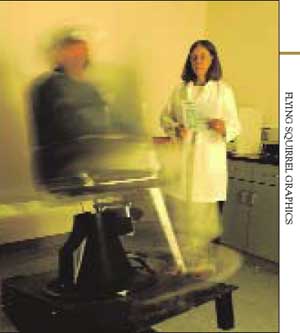Vital Signs:
Motion-sickness
study produces
dizzying findings
Some people get it by riding in a car. Others get it by sailing in a boat or flying in a plane. Some get it by watching an IMAX movie. "It" is motion sickness. And most people would do anything they could to avoid it-except, that is, for a few hardy research subjects who volunteer to ride in a spinning chair designed to make them dizzy and sick.
They are participating in a study to identify medications that are effective in preventing signs and symptoms of motion sickness, such as nausea, vomiting, and drowsiness, as well as lethargy, apathy, and a lack of initiative.
 Photo by Flying Squirrel Graphics |
| Volunteers submit to this spinning chair as part of a motion-sickness study. |
DMS internist Jay Buckey, M.D.-a former astronaut who admits to having suffered from a bit of motion sickness himself on a 10-day mission aboard the space shuttle Columbia in 1998 -is running the study. In the past, he's tested medications like dexamethasone, a non-sedating drug used to fight nausea in cancer patients. But this time he's trying the antihistamine chlorpheniramine, which is more potent and less sedating than the antihistamines like Dramamine and Benadryl typically used to treat motion sickness. A precursor of chlorpheniramine, pheniramine, was used in the 1950s to treat motion sickness among troops on transport ships.
Alert: In fact, Buckey hopes to one day find a motion sickness preventative that can be used by members of the military, space crews, and others in high-risk fields who must stay alert while trying to avoid nausea. Chlorpheniramine is a small-molecule drug, so if it works, it can be administered transdermally-that is, through the skin.
Motion sickness occurs when there is a conflict among the senses or between the senses and past experience. So, for instance, when people are standing upright, what they see as well as the feedback from their vestibular system (the equilibrium process in the inner ear) and their proprioceptor system (receptors that detect motion) all send synchronous cues to the brain-so upright individuals see a vertical image, sense being erect, and feel the ground under their feet. But conflicting cues can make a person feel sick.
Capsules: Motion sickness was induced in Buckey's 18 subjects by having them ride a chair that was tilted 15 degrees off vertical and rotated at 17 revolutions per minute. The subjects wore opaque goggles and were strapped in the chair with their heads secured to the headrest. They didn't know whether the capsules administered to them before the test began were placebos or 4- or 12-milligram doses of the drug. The results, published recently in the Journal of Vestibular Research, indicated that the high dose of chlorpheniramine was better than either the placebo or the low dose at staving off motion sickness; but the higher dose also had a sedating effect. One way to combat the sedative side effect would be to combine the drug with a stimulant like ephedrine, Buckey says; he's already begun testing that combination. He points out, however, that so far he's only evaluated chlorpheniramine as compared to a placebo and has not compared it to other established remedies.
Laura Stephenson Carter
If you would like to offer any feedback about this article, we would welcome getting your comments at DartMed@Dartmouth.edu.
